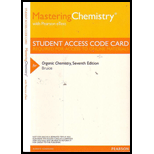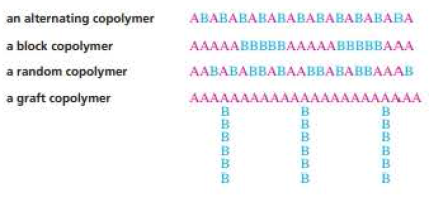
Organic Chemistry - Access
7th Edition
ISBN: 9780321820020
Author: Bruice
Publisher: PEARSON
expand_more
expand_more
format_list_bulleted
Concept explainers
Question
Chapter 27, Problem 37P
Interpretation Introduction
Interpretation:
The mechanism for the formation of the given alternating copolymer has to be proposed.
Concept Introduction:
Monomers combine together to form polymers. Monomers are the repeating units of small molecules which link together to form polymers and the process is called as
Two types of polymers:
- Synthetic and biopolymers.
- DNA is an example for biopolymer and these type of polymers are synthesized by cells.
- Polymers synthesized by scientists are called
synthetic polymers and some examples are nylon, polyester etc.
Two types of synthetic polymers:
- Chain-growth
polymers or addition polymers and step-growthpolymers or Condensation polymers. - Chain growth polymers are formed by the monomer addition to the end of a growing chain.
- Step-growth polymers are formed by combining monomers by removing small molecules of water or alcohol.
- Polymers formed from two or more different monomers are called copolymers.
- Classified into alternating copolymer, block copolymer, graft copolymer and also random copolymer.

Expert Solution & Answer
Want to see the full answer?
Check out a sample textbook solution
Students have asked these similar questions
The following two compounds form a 1 : 1 alternating copolymer. No initiator is needed for the polymerization. Propose a mechanism for formation of the copolymer.
Chain branching is not as common with anionic polymerization as it is with free-radical polymerization and cationic polymerization. Propose a mechanism for chain branching in the polymerization of acrylonitrile.
Provide the mechanism for the step-growth polymerization of citric acid and ethylene glycol to form poly (ethylene glycol)-citrate. Show all steps.
Chapter 27 Solutions
Organic Chemistry - Access
Ch. 27.2 - Prob. 1PCh. 27.2 - Prob. 2PCh. 27.2 - Prob. 3PCh. 27.2 - Prob. 4PCh. 27.2 - Prob. 5PCh. 27.2 - Prob. 6PCh. 27.2 - Prob. 7PCh. 27.2 - Rank the following groups of monomers from most...Ch. 27.2 - Why does methyl methacrylate not undergo cationic...Ch. 27.2 - Explain why, when propylene oxide undergoes...
Ch. 27.2 - Prob. 11PCh. 27.2 - Which monomer and which type of initiator can you...Ch. 27.2 - Prob. 13PCh. 27.4 - Draw a short segment of gutta-percha.Ch. 27.4 - Prob. 15PCh. 27.7 - Prob. 16PCh. 27.7 - Write an equation that explains what happens if a...Ch. 27.7 - Prob. 18PCh. 27.7 - What happens to polyester slacks if aqueous NaOH...Ch. 27.7 - a. Propose a mechanism for the formation of the...Ch. 27.7 - Explain why, when a small amount of glycerol is...Ch. 27.8 - Propose a mechanism for the formation of melmac.Ch. 27.8 - Prob. 23PCh. 27.10 - Prob. 24PCh. 27 - Draw short segments of the polymers obtained from...Ch. 27 - Prob. 26PCh. 27 - Draw the structure of the monomer or monomers used...Ch. 27 - Prob. 28PCh. 27 - Draw short segments of the polymers obtained from...Ch. 27 - Quiana is a synthetic fabric that feels very much...Ch. 27 - Prob. 31PCh. 27 - Prob. 32PCh. 27 - Poly(vinyl alcohol) is a polymer used to make...Ch. 27 - Five different repeating units are found in the...Ch. 27 - Prob. 35PCh. 27 - A particularly strong and rigid polyester used for...Ch. 27 - Prob. 37PCh. 27 - Which Monomer gives a greater yield of polymer,...Ch. 27 - Prob. 39PCh. 27 - Prob. 40PCh. 27 - Why do vinyl raincoats become brittle as they get...Ch. 27 - The polymer shown below is synthesized by...Ch. 27 - Prob. 43PCh. 27 - How can head-to-head poly(vinyl bromide) be...Ch. 27 - Delrin (polyoxymethylene) is a tough...
Knowledge Booster
Learn more about
Need a deep-dive on the concept behind this application? Look no further. Learn more about this topic, chemistry and related others by exploring similar questions and additional content below.Similar questions
- In a non-acid catalyzed step-growth polymerization between A-A and B-B monomers, the A groups are titratable by aqueous base (1 N) and [A-A] [B-B) = 6 mol.kg-1. a) What is the DP if it takes 100 mL of base to neutralize the reaction mixture at 700 minutes of reaction time (assuming the initial total weight 500 g)?...arrow_forwardPolyethylene glycol, or Carbowax®, is widely used as a binder, thickening agent, and packaging additive for foods. Propose a polymerization mechanism as far as the tetramer.arrow_forwardAlthough styrene undergoes both cationic and anionic polymerization equally well, one method is often preferred with substituted styrenes.Which method is preferred with each compound? Explain.arrow_forward
- Although styrene undergoes both cationic and anionic polymerization equally well, one method is often preferred with substituted styrenes. Which method is preferred with each compound? Explain.arrow_forwarddraw a mechanism for the polymerization of caprolactam to nylon using curved arrows to show the flow of electrons and indicate whether it is a chain reaction or a step-growth reaction.arrow_forwardWhat is the main reaction and mechanism for the polymerization of styrene? What are the side reactions?arrow_forward
- Use mechanisms to show how monomers polymerize under acidic, basic, orfree-radical conditions. For chain-growth polymerization, determine whether the reactive end is more stable as a cation (acidic conditions), anion (basic conditions), or free radical (radical initiator). For step-growth polymerization, consider the mechanism of the condensation.arrow_forwardPolyisobutylene is one of the components of butyl rubber used for making inner tubes. What conditions (cationic, anionic, free-radical) would be most appropriate for polymerization of isobutylene? Explain your answer.arrow_forwardDraw the mechanism for ziegler-natta-catalyzed polymerization of a subdtitude ethylene.arrow_forward
- Chain branching is not as common with anionic polymerization as it is with free-radical polymerization and cationic polymerization. Compare the relative stabilities of the intermediates in this mechanism with those you drew for chain branching in the cationic polymerization of styrene. Explain why chain branching is less common in this anionic polymerization.arrow_forwardDraw/sketch and describe a three dimensional representation of a isotactic polyvinyl bromide with a degree of polymerization equal to 6arrow_forwardRadical polymerization of styrene gives a linear polymer. Radical polymerization of a mixture of styrene and 1,4-divinylbenzene gives a cross-linked network polymer of the type shown in Figure 29.1. Show by drawing structural formulas how incorporation of a few percent of 1,4-divinylbenzene in the polymerization mixture gives a cross-linked polymer.arrow_forward
arrow_back_ios
SEE MORE QUESTIONS
arrow_forward_ios
Recommended textbooks for you
 Organic ChemistryChemistryISBN:9781305580350Author:William H. Brown, Brent L. Iverson, Eric Anslyn, Christopher S. FootePublisher:Cengage Learning
Organic ChemistryChemistryISBN:9781305580350Author:William H. Brown, Brent L. Iverson, Eric Anslyn, Christopher S. FootePublisher:Cengage Learning
 Chemistry: Principles and PracticeChemistryISBN:9780534420123Author:Daniel L. Reger, Scott R. Goode, David W. Ball, Edward MercerPublisher:Cengage Learning
Chemistry: Principles and PracticeChemistryISBN:9780534420123Author:Daniel L. Reger, Scott R. Goode, David W. Ball, Edward MercerPublisher:Cengage Learning

Organic Chemistry
Chemistry
ISBN:9781305580350
Author:William H. Brown, Brent L. Iverson, Eric Anslyn, Christopher S. Foote
Publisher:Cengage Learning


Chemistry: Principles and Practice
Chemistry
ISBN:9780534420123
Author:Daniel L. Reger, Scott R. Goode, David W. Ball, Edward Mercer
Publisher:Cengage Learning